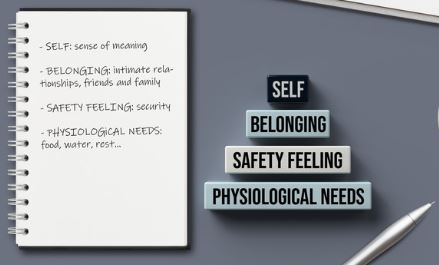Let’s Talk About Sex: The Many Faces of Sexual Dysfunction
Posted by: Men's Health Boston in Uncategorized on October 31, 2022
If you ever took a high school or college psychology class, there’s a good chance you’re familiar with Maslow’s Hierarchy of Needs.
Developed by American psychologist Abraham Maslow in a 1943 paper describing drivers of human motivation, the theory is often depicted as a pyramid, with physiological necessities such as sleep, food, and water at the bottom, and more complex social needs further up the scale.

Interestingly, since the inception of this landmark theory, there has been a lot of debate over where sex falls on the continuum: is it a “physiological drive”, a form of “security”, a component of “love and belonging”? We won’t pretend to have the answer to that question, because sex drive itself appears to be highly individual.
However, at Men’s Health Boston, we’ve been treating men and women with sexual dysfunction for over 20 years, and we can tell you beyond a shadow of a doubt that when your sex life feels broken, it has a significant and severe impact on your overall quality of life. And it’s time to normalize talking about it.
So, in this month’s blog post, we wanted to bring this discussion into the light. We want to describe the many of the faces of sexual dysfunction that we see regularly in our clinic, in hopes that it gives you both the license and the language to have sometimes uncomfortable but absolutely critical conversations with your healthcare providers.
Face #1: Erectile Dysfunction
Estimated to affect nearly 30 million men in the United States, erectile dysfunction is one of the most common conditions we see in our clinic. Men who seek us out for treatment frequently describe the corrosive effects ED has on their personal lives:
- They struggle with self-esteem issues related to performance anxiety
- They report tension, frustration, and exhaustion in their intimate relationships
- Rather than pleasure, sex becomes associated with embarrassment and failure
It’s not just older men who struggle with these issues. ED can affect guys at any stage of life, and arises from a complex interplay of physical AND psychological factors (see “How do Erections Happen?”).
If you are dealing with erectile dysfunction, it can feel like it has taken over your life. Don’t let it isolate you. Many treatments are available and are, in the majority of cases, associated with a drastic improvement in quality of life. Seek out a practitioner who you feel comfortable speaking to honestly about your concerns, who will listen and work with you to diagnose the underlying problems.
Face #2: Hormonal Dysfunction (and Loss of Libido)
At MHB, we’ve been providing testosterone replacement therapy for over 22 years as leaders in the field, and in that time, we have helped thousands of men reclaim their confidence, energy, and sense of freedom.

Testosterone deficiency is incredibly common, estimated to affect up to 40% of adult men in the United States. In addition, recently published research has suggested that testosterone levels are declining even among the healthy Adolescent and Young Adult men (AYA) population.
For men who experience the effects of low testosterone (also called “hypogonadism”), treatment can mean the difference between:
- Exhaustion and chronic fatigue vs. mental focus and adequate energy
- Depression, irritability, and mood swings vs. a return in sense-of-wellbeing and vitality
- Increased weight and bodyfat accumulation vs. enhanced muscle tone and strength
- Weak, flaccid erections vs. reliable sexual performance
- Embarrassment and frustration with intimacy vs. a return of self-esteem and sexual virility
There’s also a pervasive myth that testosterone is strictly a male hormone, and estrogen is the female equivalent. While there are important sex-specific characteristics driven by the balance of each of these hormones produced in the body, it’s also true that BOTH hormones are critical for proper function in BOTH sexes.
Here’s a little known fact to impress at your next dinner party: despite popular belief, testosterone is still the most abundant biologically active sex hormone in women throughout their lifespan. It should be no surprise, then, that many women experience a return of their sex drive when proper testosterone levels are restored.
Face #3: Pelvic Floor Dysfunction and Urinary Incontinence
In our practice, we see a lot of folks suffering from urinary incontinence. It’s often associated with structural changes in anatomy, as a result of childbirth, an enlarged prostate, or even a full prostate removal. For those afflicted, incontinence can be really embarrassing, and cause anxiety and avoidance in leaving the house.
Increasingly, the same muscles associated with bladder control are being linked to sexual dysfunction in both women and men. These muscles, known collectively as the “pelvic floor”, play a pivotal role in regulating the organs around them, and proper action seems intimately linked to more than just bladder control. Improved blood flow and muscle relaxation in the pubic region are research-backed mechanisms to improve erections, reduce pain associated with intercourse in both sexes, and enhance orgasm potential.
Pelvic Floor dysfunction has traditionally been treated by referring out to a specialized physical therapist for targeted exercises such as Kegels. While these programs have been shown to produce good outcomes, as with any PT therapy, they require an investment of time, patience, and consistent practice. And while some patients find this difficult to stick with, there haven’t been many treatment alternatives.
That is, until recently. At MHB, we are early adopters of an exciting new medical device called the EMSELLA chair by BTL. One simple, 30-minute session rivals 12,000 repetitions of Kegel exercises, drastically reducing the ease and time investment required to see results. To find out more about this ground-breaking therapy and how it works, check out our blog post from July, where we dive deep on the topic of pelvic floor dysfunction.
Face #4: Peyronie’s Disease

In Peyronie’s disease, fibrous bands of scar tissue develop within the penis over long periods of time, typically in response to small repeated traumas thought to occur during sexual intercourse. This creates a “drawbridge-like effect”, in which the shaft of the penis bends at an abnormal angle, often beyond 30 degrees. We wrote extensively on this condition in a past blog post, including the causes and symptoms, and the different treatments we offer to men who seek help at our clinic.
One of the most insidious problems in Peyronie’s is that a lot of men suffering from the condition don’t seek treatment until curvature is severe, leading to major difficulties in physical intimacy with their partner. Many men suffer in silence unnecessarily, whether out of embarrassment or a general lack of awareness that medications and therapeutic options exist.
So if you or someone you know is dealing with Peyronie’s, know this: things can get better. Don’t wait until your sex life is on the ropes to seek out help.
How can I schedule a consultation?
Living in the shadow of sexual dysfunction and frustration takes a toll on your mental and physical health. And it doesn’t need to be this way. The sooner you seek help, the faster you can get back to having the energy and attention for all of the other important moments life has to offer.
If you or someone you know are suffering, we’re here to help. For more information on our industry-leading care at MHB, click here. For a clinical evaluation, call our office or request an appointment with one of our expert practitioners today.

